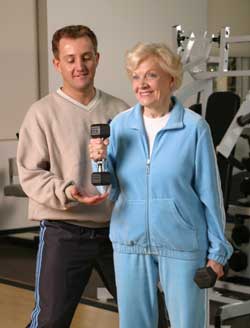When daily trips to the gym aren’t possible or gym memberships seem a little too expensive, home exercise equipment might seem like a good alternative. But before you spring for new equipment, make sure you’re not buying the fitness fiction of quick, easy results. When shopping, look for equipment that suits your lifestyle and budget, and shop around to get the best price.
What the Ads Say
Home exercise equipment can be a great way to shape up — but only if you use it regularly. Ads promising quick, easy results are selling a line, not a reality. Here are some claims to watch for:
It’s quick, easy, and effortless.
Whether they're promoting shoes, clothing, or equipment, some advertisers say their products offer a quick, easy way to shape up and lose weight — without sound science to back it up. There's no such thing as a no-work, no-sweat way to a fit, healthy body. To get the benefits of exercise, you have to do the work. For more on pills and products promising easy weight loss, read Weighing the Claims in Diet Ads.
We promise to fix your problem areas.
Promises that you can effortlessly burn a spare tire or melt fat from your hips and thighs are tempting, but spot reduction — losing weight in a specific place — takes regular exercise that still works the whole body to burn extra calories.
For information about electronic muscle stimulators, which may be able to temporarily strengthen, tone, or firm a muscle, but typically are intended for use in physical therapy and rehabilitation under the supervision of a health care professional, see FDA’s website.
Look at these before-and-after photos.
They may be “satisfied customers,” but their experiences may not reflect the results most users get. And celebrity endorsements? They're no proof the product will work as claimed, either. As for the chiseled models in the ads, is that six-pack the result of the product they're promoting, months in the gym and years of healthy habits, or an altered photo?
What to Do Before You Buy Exercise Equipment
You’ve done your job and looked at any claims with a skeptical, savvy eye. But you’re not quite finished. Before you buy any equipment, here are a few tips to make sure your new gear won’t wind up collecting dust:
Start working out.
Don’t expect the equipment to change your habits. Are you ready to act on your good intentions? If you’re not active already, start now.
Find the right equipment.
Take a test drive. Before you buy, give different equipment a test drive at a local gym, recreation center, retailer, or even a friend’s place.
Read reviews. Check out consumer and fitness magazines that rate exercise equipment to get an idea of how a product performs, and whether it’s likely to help you achieve your goal, whether it’s building strength, increasing flexibility, improving endurance, or enhancing your health. You also can check out user reviews online. Just don't put all your trust in any one review. Try typing the product or manufacturer’s name into a search engine, along with terms like “complaint” or “problem.”
Find the right price.
Find out the real cost. Some companies advertise "three easy payments of $49.95.” Break out the calculator and figure out what you’ll really pay. Don’t forget sales tax and shipping or delivery charges. Find out about warranties, and whether shipping or restocking fees apply if you decide to send it back.
Shop around. That one-of-a-kind fitness product may be available at a better price from a local store, or you might get a better deal online. Factor in delivery costs.
July 2012



 By Jonathan Ross
By Jonathan Ross To manage weight, you need to determine the number of calories you eat and the number of calories you burn. Your body has something called the basal metabolic rate (BMR), which is the amount of calories you burn at rest in order to survive. It accounts for roughly 60 to 75% of all the calories you burn in a given day. That’s right—you are actually burning a small amount of calories while you are sleeping.
To manage weight, you need to determine the number of calories you eat and the number of calories you burn. Your body has something called the basal metabolic rate (BMR), which is the amount of calories you burn at rest in order to survive. It accounts for roughly 60 to 75% of all the calories you burn in a given day. That’s right—you are actually burning a small amount of calories while you are sleeping.
